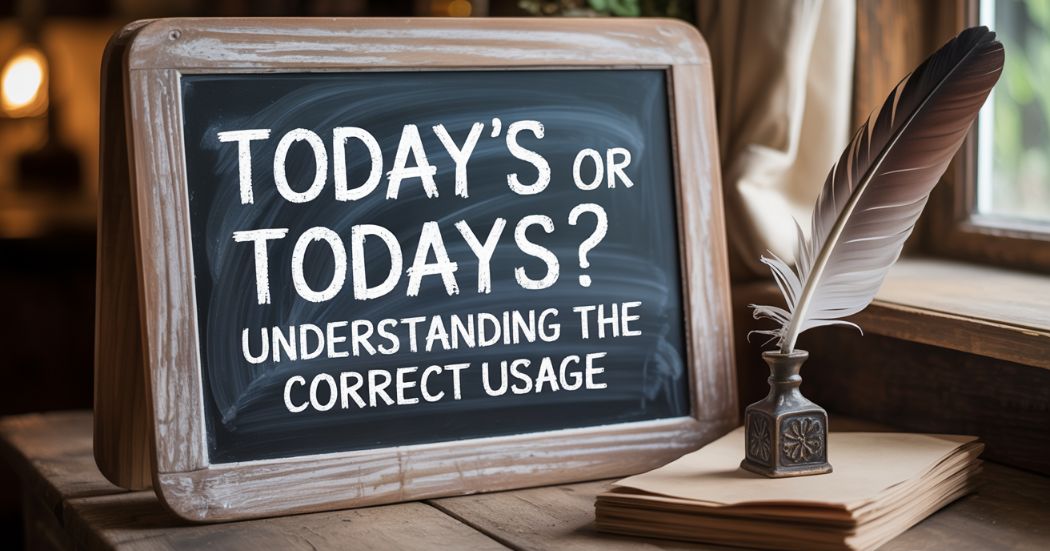The English language is rich with subtle nuances that can trip up even the most seasoned speakers and writers. One such example is the confusion between today’s and todays. While they may seem similar at first glance, they serve different grammatical purposes, and understanding the distinction can greatly enhance your writing clarity.
What Does “Today’s” Mean?
“Today’s” is a possessive form of the word “today,” indicating that something belongs to or is associated with the current day. It’s used to express ownership, time relevance, or something related to today.
For instance, consider this sentence:
- “Today’s meeting has been postponed.”
In this case, “today’s” is used to show that the meeting is scheduled for today, and it conveys ownership of the meeting by the day.
Scenario Example 1: Possession of Events
Let’s say you are organizing a conference, and you are talking about an agenda. You would use “today’s” to emphasize events happening today:
- “Today’s keynote speaker will discuss innovation in technology.”
This shows that the speaker, and possibly the topic, are connected to today’s schedule.
Scenario Example 2: Reflecting Time Sensitivity
If you are talking about a news update that pertains specifically to today, “today’s” would make sense:
- “In today’s news, experts discuss the impact of climate change.”
Here, “today’s” is used to reference a news event that is relevant to today.
In short, “today’s” signifies possession or something related to the present day, and it is a grammatical marker to indicate that the action or event belongs to today.
What About “Todays”?
On the other hand, “todays” without the apostrophe is almost always incorrect in standard English. It might appear in informal writing or errors, but grammatically speaking, it doesn’t have a place in the language. However, some might mistakenly think it’s the plural form of “today,” but it’s important to recognize that this form doesn’t exist in English.
Why “Todays” Is Incorrect
“Today” is a singular noun and does not have a plural form. You cannot pluralize “today” because it’s already referencing the entire 24-hour period. In essence, “todays” is a misstep in grammatical construction. For example:
- Incorrect: “We will discuss the events of todays meeting.”
- Correct: “We will discuss the events of today’s meeting.”
Using todays would confuse the meaning and make the sentence seem ungrammatical.
Common Mistakes: Why People Get Confused
The confusion between today’s and todays often stems from the rules of possession and pluralization in English. We are accustomed to adding an “s” to nouns to indicate a plural, and sometimes we mistakenly apply this to time-based nouns like “today.”
Additionally, homophones and near-homophones are another reason people make these errors. For example, words like “it’s” vs. “its,” or “there” vs. “their,” are often mixed up because of their phonetic similarity. Similarly, today’s and todays sound so similar, which can lead to writing errors.
Possessive Form vs. Plural Form: Key Differences
Understanding the possessive form (today’s) and the plural form is crucial in avoiding these mistakes. In English, adding an apostrophe and “s” denotes possession or association with something, not plurality. In contrast, adding only an “s” is the correct method of forming plural nouns.
Let’s break down a simple example:
- “Today’s agenda” refers to the agenda that belongs to today.
- “Todays” does not exist in this context because you cannot pluralize “today.”
Scenario Example 3: Time-Related Discussions
Consider a scenario in which you are planning multiple events that happen on different days. In this case, you wouldn’t say “todays events.” Instead, you would structure your sentence differently:
- “The events of today are crucial for the success of the project.”
- “We’ve planned various meetings for the next few days.” (if you want to indicate multiple days)
This illustrates how we need to form phrases using the correct possessive, rather than attempting to pluralize time-related words.
Why the Apostrophe Is Important
The apostrophe in today’s plays a pivotal role in conveying the right meaning. Without it, the sentence could become confusing or nonsensical. It marks the possessive case and signals that something is connected to “today.” In the absence of the apostrophe, the form “todays” can create ambiguity, making the writing look unprofessional.
Consider this simple example:
- Correct: “Today’s weather forecast looks promising.”
- Incorrect: “Todays weather forecast looks promising.”
The second sentence not only appears incorrect but also may confuse the reader since “todays” is not a valid word in this context.
Examples of “Today’s” in Different Contexts
Scenario Example 4: Business Context
In business emails or reports, the use of today’s is commonplace, especially when you need to highlight something specific happening during the day:
- “Today’s sales figures show a positive trend compared to last month.”
In this case, you’re showing that the sales figures belong to or are relevant to today.
Scenario Example 5: Personal Context
Even in everyday, casual conversations, today’s is still the correct form to use when discussing something tied to the present day:
- “I’m going to finish today’s tasks before heading out.”
Here, the sentence demonstrates ownership of the tasks, specifically indicating they are set for completion today.
Conclusion: The Takeaway
Understanding the difference between today’s and todays is a crucial part of mastering English grammar. “Today’s” is the correct form when indicating possession or relevance to today, while “todays” is a grammatical error and should be avoided.
Here’s a summary of the key points:
- “Today’s” is a possessive form, showing ownership or connection to the present day.
- “Todays” does not exist in standard English.
- Use an apostrophe to show possession or relevance to today (e.g., “Today’s event,” “Today’s weather”).
- Avoid using “todays” in place of “today’s.”


